Report on Diversity, Equality, and Inclusion in HRM Practices in UK
VerifiedAdded on 2023/01/03
|10
|2948
|61
Report
AI Summary
This report delves into the critical aspects of managing human resources with a focus on diversity, equality, and inclusion in the UK workplace. It begins by establishing the moral and business cases for diversity and inclusion, highlighting the benefits of a diverse workforce and inclusive culture. The report then examines key UK legislations, particularly the Equality Act 2010, and their impact on recruitment and selection processes. It addresses the issue of the glass ceiling and provides steps to combat it, along with a detailed explanation of direct and indirect discrimination. Furthermore, the report explores exceptional circumstances where organizations can claim exemptions from legislation, the legal position of positive action, and the provisions of the Rehabilitation of Offenders Act 1974. Finally, it outlines practical policies for fostering diversity, equality, and inclusion in the workplace, providing a comprehensive overview of the topic for students and professionals alike.
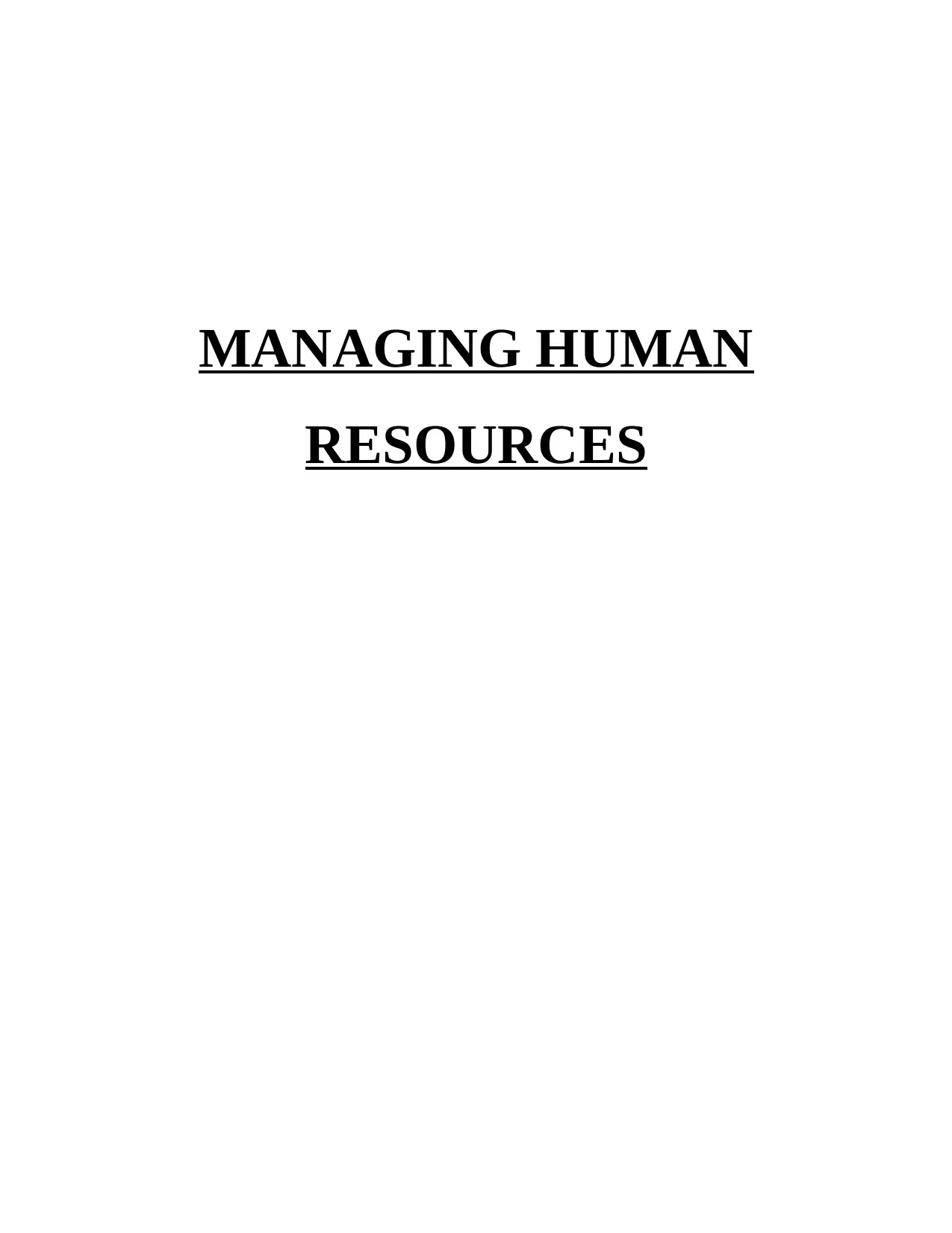
MANAGING HUMAN
RESOURCES
RESOURCES
Paraphrase This Document
Need a fresh take? Get an instant paraphrase of this document with our AI Paraphraser
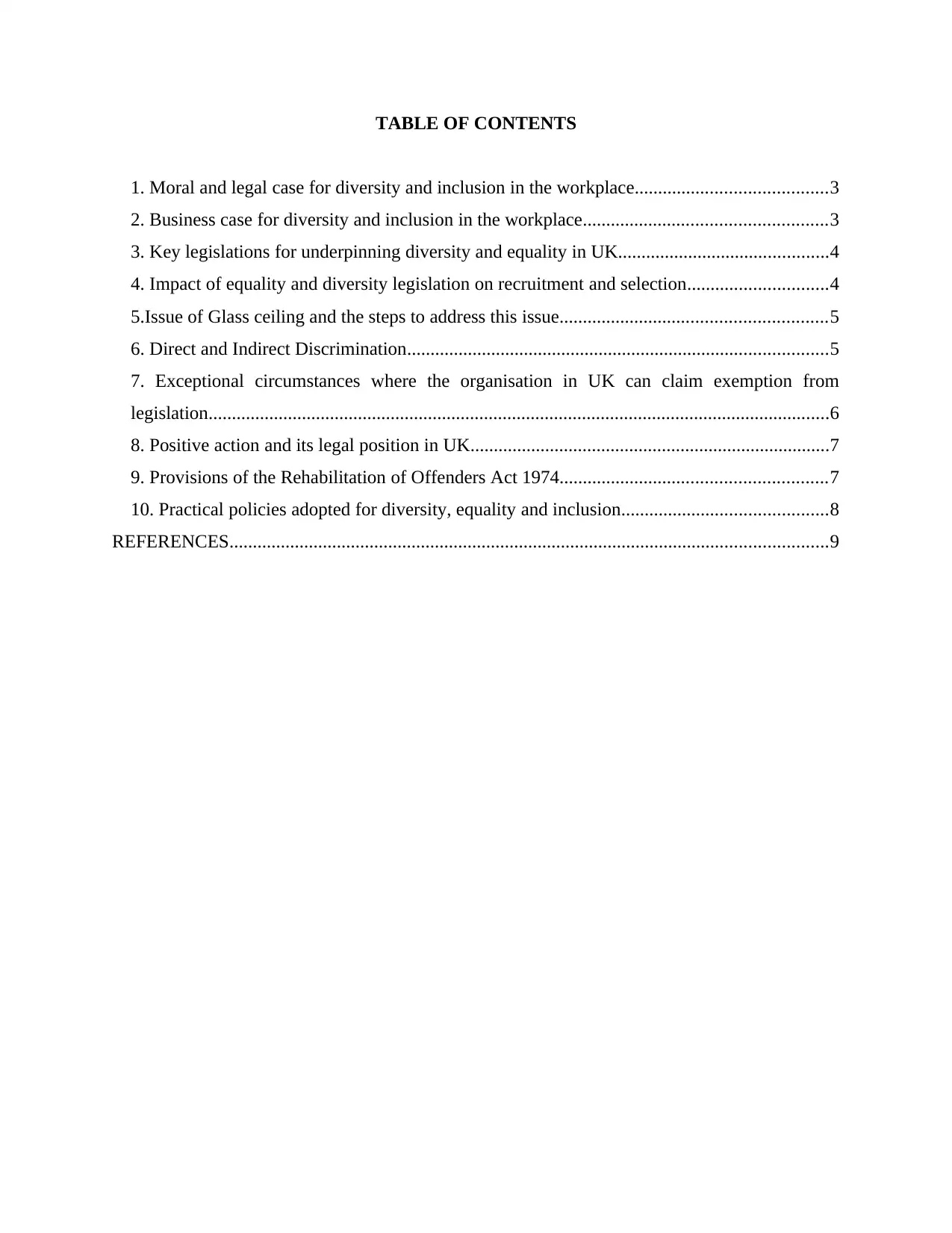
TABLE OF CONTENTS
1. Moral and legal case for diversity and inclusion in the workplace.........................................3
2. Business case for diversity and inclusion in the workplace....................................................3
3. Key legislations for underpinning diversity and equality in UK.............................................4
4. Impact of equality and diversity legislation on recruitment and selection..............................4
5.Issue of Glass ceiling and the steps to address this issue.........................................................5
6. Direct and Indirect Discrimination..........................................................................................5
7. Exceptional circumstances where the organisation in UK can claim exemption from
legislation.....................................................................................................................................6
8. Positive action and its legal position in UK.............................................................................7
9. Provisions of the Rehabilitation of Offenders Act 1974.........................................................7
10. Practical policies adopted for diversity, equality and inclusion............................................8
REFERENCES................................................................................................................................9
1. Moral and legal case for diversity and inclusion in the workplace.........................................3
2. Business case for diversity and inclusion in the workplace....................................................3
3. Key legislations for underpinning diversity and equality in UK.............................................4
4. Impact of equality and diversity legislation on recruitment and selection..............................4
5.Issue of Glass ceiling and the steps to address this issue.........................................................5
6. Direct and Indirect Discrimination..........................................................................................5
7. Exceptional circumstances where the organisation in UK can claim exemption from
legislation.....................................................................................................................................6
8. Positive action and its legal position in UK.............................................................................7
9. Provisions of the Rehabilitation of Offenders Act 1974.........................................................7
10. Practical policies adopted for diversity, equality and inclusion............................................8
REFERENCES................................................................................................................................9
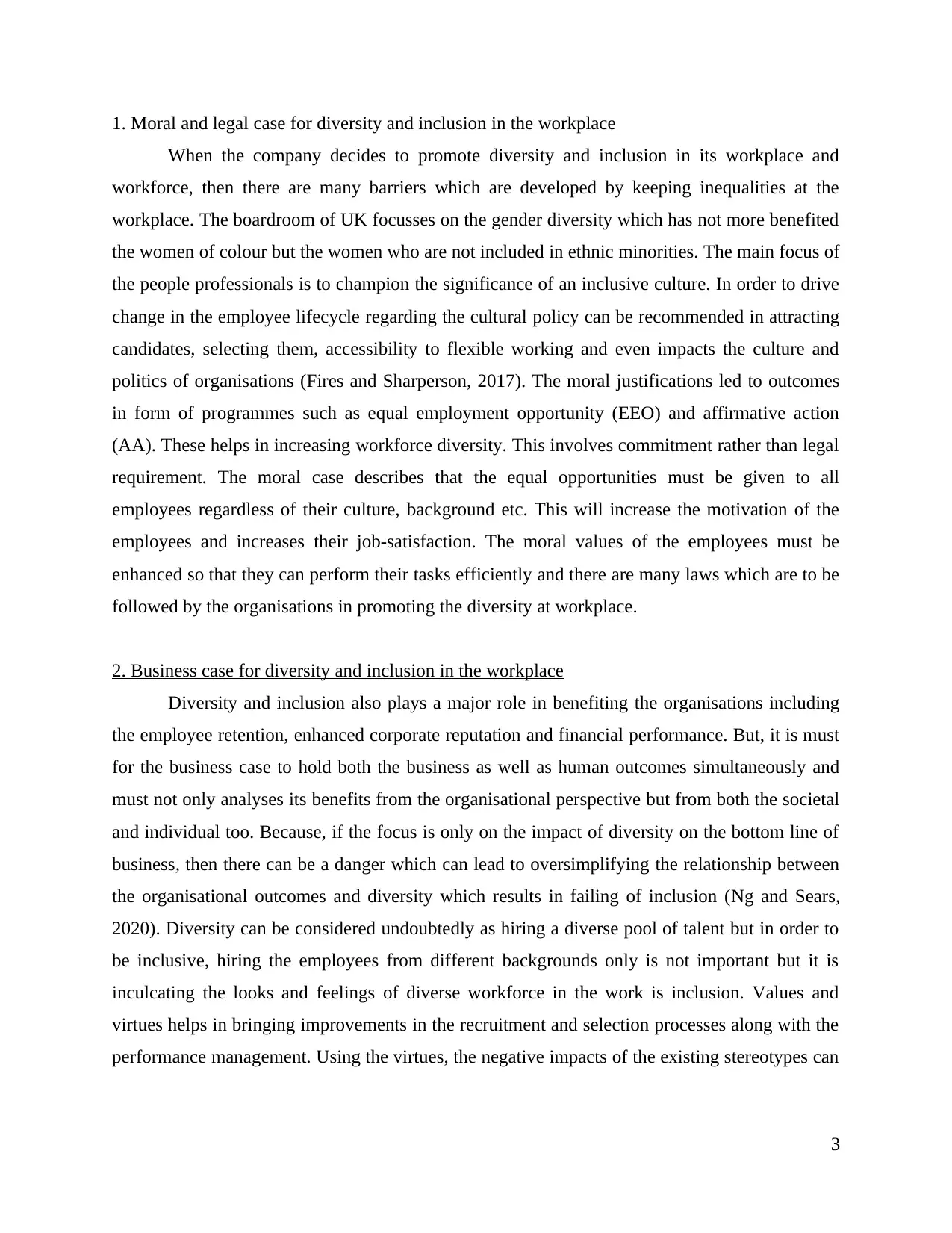
1. Moral and legal case for diversity and inclusion in the workplace
When the company decides to promote diversity and inclusion in its workplace and
workforce, then there are many barriers which are developed by keeping inequalities at the
workplace. The boardroom of UK focusses on the gender diversity which has not more benefited
the women of colour but the women who are not included in ethnic minorities. The main focus of
the people professionals is to champion the significance of an inclusive culture. In order to drive
change in the employee lifecycle regarding the cultural policy can be recommended in attracting
candidates, selecting them, accessibility to flexible working and even impacts the culture and
politics of organisations (Fires and Sharperson, 2017). The moral justifications led to outcomes
in form of programmes such as equal employment opportunity (EEO) and affirmative action
(AA). These helps in increasing workforce diversity. This involves commitment rather than legal
requirement. The moral case describes that the equal opportunities must be given to all
employees regardless of their culture, background etc. This will increase the motivation of the
employees and increases their job-satisfaction. The moral values of the employees must be
enhanced so that they can perform their tasks efficiently and there are many laws which are to be
followed by the organisations in promoting the diversity at workplace.
2. Business case for diversity and inclusion in the workplace
Diversity and inclusion also plays a major role in benefiting the organisations including
the employee retention, enhanced corporate reputation and financial performance. But, it is must
for the business case to hold both the business as well as human outcomes simultaneously and
must not only analyses its benefits from the organisational perspective but from both the societal
and individual too. Because, if the focus is only on the impact of diversity on the bottom line of
business, then there can be a danger which can lead to oversimplifying the relationship between
the organisational outcomes and diversity which results in failing of inclusion (Ng and Sears,
2020). Diversity can be considered undoubtedly as hiring a diverse pool of talent but in order to
be inclusive, hiring the employees from different backgrounds only is not important but it is
inculcating the looks and feelings of diverse workforce in the work is inclusion. Values and
virtues helps in bringing improvements in the recruitment and selection processes along with the
performance management. Using the virtues, the negative impacts of the existing stereotypes can
3
When the company decides to promote diversity and inclusion in its workplace and
workforce, then there are many barriers which are developed by keeping inequalities at the
workplace. The boardroom of UK focusses on the gender diversity which has not more benefited
the women of colour but the women who are not included in ethnic minorities. The main focus of
the people professionals is to champion the significance of an inclusive culture. In order to drive
change in the employee lifecycle regarding the cultural policy can be recommended in attracting
candidates, selecting them, accessibility to flexible working and even impacts the culture and
politics of organisations (Fires and Sharperson, 2017). The moral justifications led to outcomes
in form of programmes such as equal employment opportunity (EEO) and affirmative action
(AA). These helps in increasing workforce diversity. This involves commitment rather than legal
requirement. The moral case describes that the equal opportunities must be given to all
employees regardless of their culture, background etc. This will increase the motivation of the
employees and increases their job-satisfaction. The moral values of the employees must be
enhanced so that they can perform their tasks efficiently and there are many laws which are to be
followed by the organisations in promoting the diversity at workplace.
2. Business case for diversity and inclusion in the workplace
Diversity and inclusion also plays a major role in benefiting the organisations including
the employee retention, enhanced corporate reputation and financial performance. But, it is must
for the business case to hold both the business as well as human outcomes simultaneously and
must not only analyses its benefits from the organisational perspective but from both the societal
and individual too. Because, if the focus is only on the impact of diversity on the bottom line of
business, then there can be a danger which can lead to oversimplifying the relationship between
the organisational outcomes and diversity which results in failing of inclusion (Ng and Sears,
2020). Diversity can be considered undoubtedly as hiring a diverse pool of talent but in order to
be inclusive, hiring the employees from different backgrounds only is not important but it is
inculcating the looks and feelings of diverse workforce in the work is inclusion. Values and
virtues helps in bringing improvements in the recruitment and selection processes along with the
performance management. Using the virtues, the negative impacts of the existing stereotypes can
3
⊘ This is a preview!⊘
Do you want full access?
Subscribe today to unlock all pages.

Trusted by 1+ million students worldwide
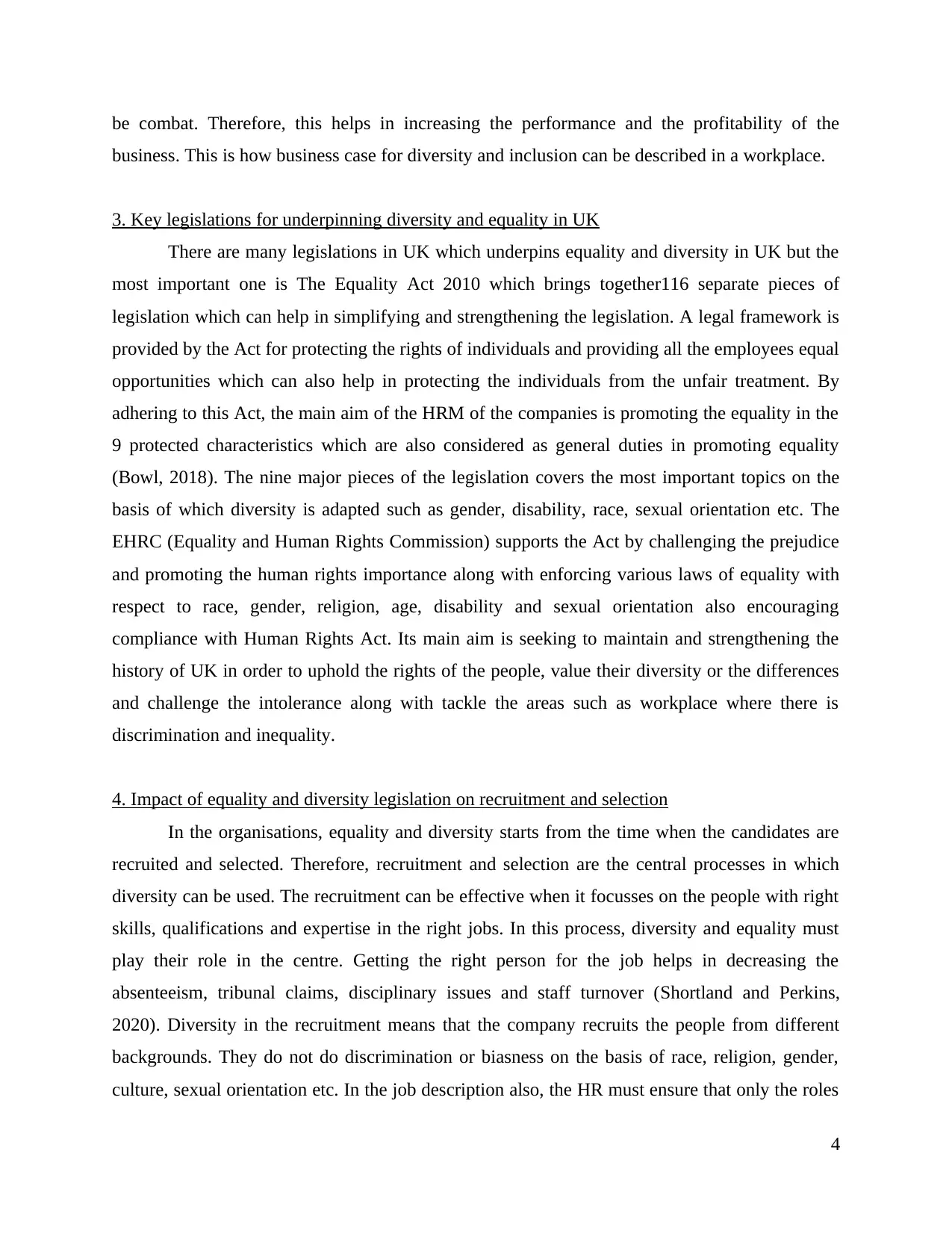
be combat. Therefore, this helps in increasing the performance and the profitability of the
business. This is how business case for diversity and inclusion can be described in a workplace.
3. Key legislations for underpinning diversity and equality in UK
There are many legislations in UK which underpins equality and diversity in UK but the
most important one is The Equality Act 2010 which brings together116 separate pieces of
legislation which can help in simplifying and strengthening the legislation. A legal framework is
provided by the Act for protecting the rights of individuals and providing all the employees equal
opportunities which can also help in protecting the individuals from the unfair treatment. By
adhering to this Act, the main aim of the HRM of the companies is promoting the equality in the
9 protected characteristics which are also considered as general duties in promoting equality
(Bowl, 2018). The nine major pieces of the legislation covers the most important topics on the
basis of which diversity is adapted such as gender, disability, race, sexual orientation etc. The
EHRC (Equality and Human Rights Commission) supports the Act by challenging the prejudice
and promoting the human rights importance along with enforcing various laws of equality with
respect to race, gender, religion, age, disability and sexual orientation also encouraging
compliance with Human Rights Act. Its main aim is seeking to maintain and strengthening the
history of UK in order to uphold the rights of the people, value their diversity or the differences
and challenge the intolerance along with tackle the areas such as workplace where there is
discrimination and inequality.
4. Impact of equality and diversity legislation on recruitment and selection
In the organisations, equality and diversity starts from the time when the candidates are
recruited and selected. Therefore, recruitment and selection are the central processes in which
diversity can be used. The recruitment can be effective when it focusses on the people with right
skills, qualifications and expertise in the right jobs. In this process, diversity and equality must
play their role in the centre. Getting the right person for the job helps in decreasing the
absenteeism, tribunal claims, disciplinary issues and staff turnover (Shortland and Perkins,
2020). Diversity in the recruitment means that the company recruits the people from different
backgrounds. They do not do discrimination or biasness on the basis of race, religion, gender,
culture, sexual orientation etc. In the job description also, the HR must ensure that only the roles
4
business. This is how business case for diversity and inclusion can be described in a workplace.
3. Key legislations for underpinning diversity and equality in UK
There are many legislations in UK which underpins equality and diversity in UK but the
most important one is The Equality Act 2010 which brings together116 separate pieces of
legislation which can help in simplifying and strengthening the legislation. A legal framework is
provided by the Act for protecting the rights of individuals and providing all the employees equal
opportunities which can also help in protecting the individuals from the unfair treatment. By
adhering to this Act, the main aim of the HRM of the companies is promoting the equality in the
9 protected characteristics which are also considered as general duties in promoting equality
(Bowl, 2018). The nine major pieces of the legislation covers the most important topics on the
basis of which diversity is adapted such as gender, disability, race, sexual orientation etc. The
EHRC (Equality and Human Rights Commission) supports the Act by challenging the prejudice
and promoting the human rights importance along with enforcing various laws of equality with
respect to race, gender, religion, age, disability and sexual orientation also encouraging
compliance with Human Rights Act. Its main aim is seeking to maintain and strengthening the
history of UK in order to uphold the rights of the people, value their diversity or the differences
and challenge the intolerance along with tackle the areas such as workplace where there is
discrimination and inequality.
4. Impact of equality and diversity legislation on recruitment and selection
In the organisations, equality and diversity starts from the time when the candidates are
recruited and selected. Therefore, recruitment and selection are the central processes in which
diversity can be used. The recruitment can be effective when it focusses on the people with right
skills, qualifications and expertise in the right jobs. In this process, diversity and equality must
play their role in the centre. Getting the right person for the job helps in decreasing the
absenteeism, tribunal claims, disciplinary issues and staff turnover (Shortland and Perkins,
2020). Diversity in the recruitment means that the company recruits the people from different
backgrounds. They do not do discrimination or biasness on the basis of race, religion, gender,
culture, sexual orientation etc. In the job description also, the HR must ensure that only the roles
4
Paraphrase This Document
Need a fresh take? Get an instant paraphrase of this document with our AI Paraphraser
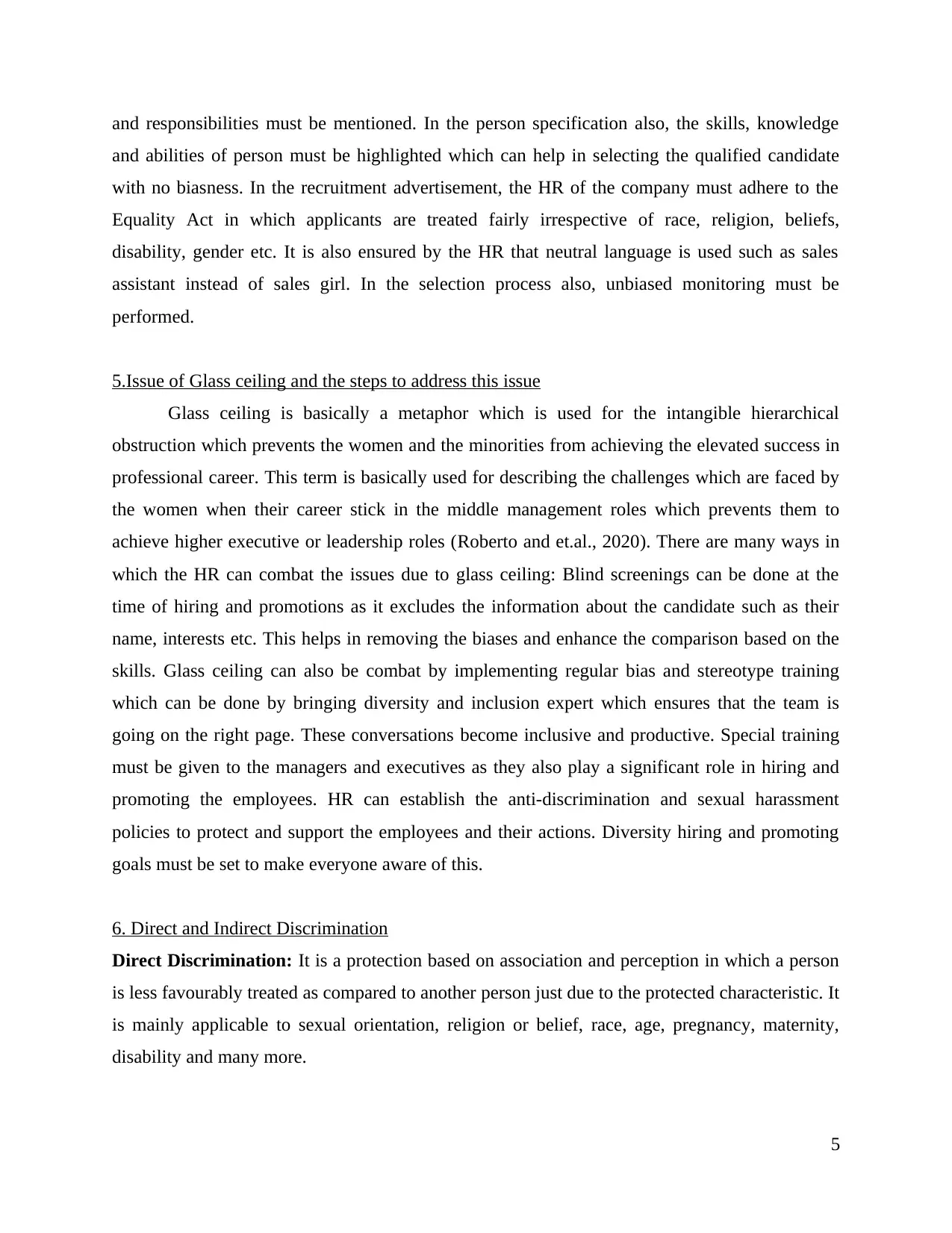
and responsibilities must be mentioned. In the person specification also, the skills, knowledge
and abilities of person must be highlighted which can help in selecting the qualified candidate
with no biasness. In the recruitment advertisement, the HR of the company must adhere to the
Equality Act in which applicants are treated fairly irrespective of race, religion, beliefs,
disability, gender etc. It is also ensured by the HR that neutral language is used such as sales
assistant instead of sales girl. In the selection process also, unbiased monitoring must be
performed.
5.Issue of Glass ceiling and the steps to address this issue
Glass ceiling is basically a metaphor which is used for the intangible hierarchical
obstruction which prevents the women and the minorities from achieving the elevated success in
professional career. This term is basically used for describing the challenges which are faced by
the women when their career stick in the middle management roles which prevents them to
achieve higher executive or leadership roles (Roberto and et.al., 2020). There are many ways in
which the HR can combat the issues due to glass ceiling: Blind screenings can be done at the
time of hiring and promotions as it excludes the information about the candidate such as their
name, interests etc. This helps in removing the biases and enhance the comparison based on the
skills. Glass ceiling can also be combat by implementing regular bias and stereotype training
which can be done by bringing diversity and inclusion expert which ensures that the team is
going on the right page. These conversations become inclusive and productive. Special training
must be given to the managers and executives as they also play a significant role in hiring and
promoting the employees. HR can establish the anti-discrimination and sexual harassment
policies to protect and support the employees and their actions. Diversity hiring and promoting
goals must be set to make everyone aware of this.
6. Direct and Indirect Discrimination
Direct Discrimination: It is a protection based on association and perception in which a person
is less favourably treated as compared to another person just due to the protected characteristic. It
is mainly applicable to sexual orientation, religion or belief, race, age, pregnancy, maternity,
disability and many more.
5
and abilities of person must be highlighted which can help in selecting the qualified candidate
with no biasness. In the recruitment advertisement, the HR of the company must adhere to the
Equality Act in which applicants are treated fairly irrespective of race, religion, beliefs,
disability, gender etc. It is also ensured by the HR that neutral language is used such as sales
assistant instead of sales girl. In the selection process also, unbiased monitoring must be
performed.
5.Issue of Glass ceiling and the steps to address this issue
Glass ceiling is basically a metaphor which is used for the intangible hierarchical
obstruction which prevents the women and the minorities from achieving the elevated success in
professional career. This term is basically used for describing the challenges which are faced by
the women when their career stick in the middle management roles which prevents them to
achieve higher executive or leadership roles (Roberto and et.al., 2020). There are many ways in
which the HR can combat the issues due to glass ceiling: Blind screenings can be done at the
time of hiring and promotions as it excludes the information about the candidate such as their
name, interests etc. This helps in removing the biases and enhance the comparison based on the
skills. Glass ceiling can also be combat by implementing regular bias and stereotype training
which can be done by bringing diversity and inclusion expert which ensures that the team is
going on the right page. These conversations become inclusive and productive. Special training
must be given to the managers and executives as they also play a significant role in hiring and
promoting the employees. HR can establish the anti-discrimination and sexual harassment
policies to protect and support the employees and their actions. Diversity hiring and promoting
goals must be set to make everyone aware of this.
6. Direct and Indirect Discrimination
Direct Discrimination: It is a protection based on association and perception in which a person
is less favourably treated as compared to another person just due to the protected characteristic. It
is mainly applicable to sexual orientation, religion or belief, race, age, pregnancy, maternity,
disability and many more.
5
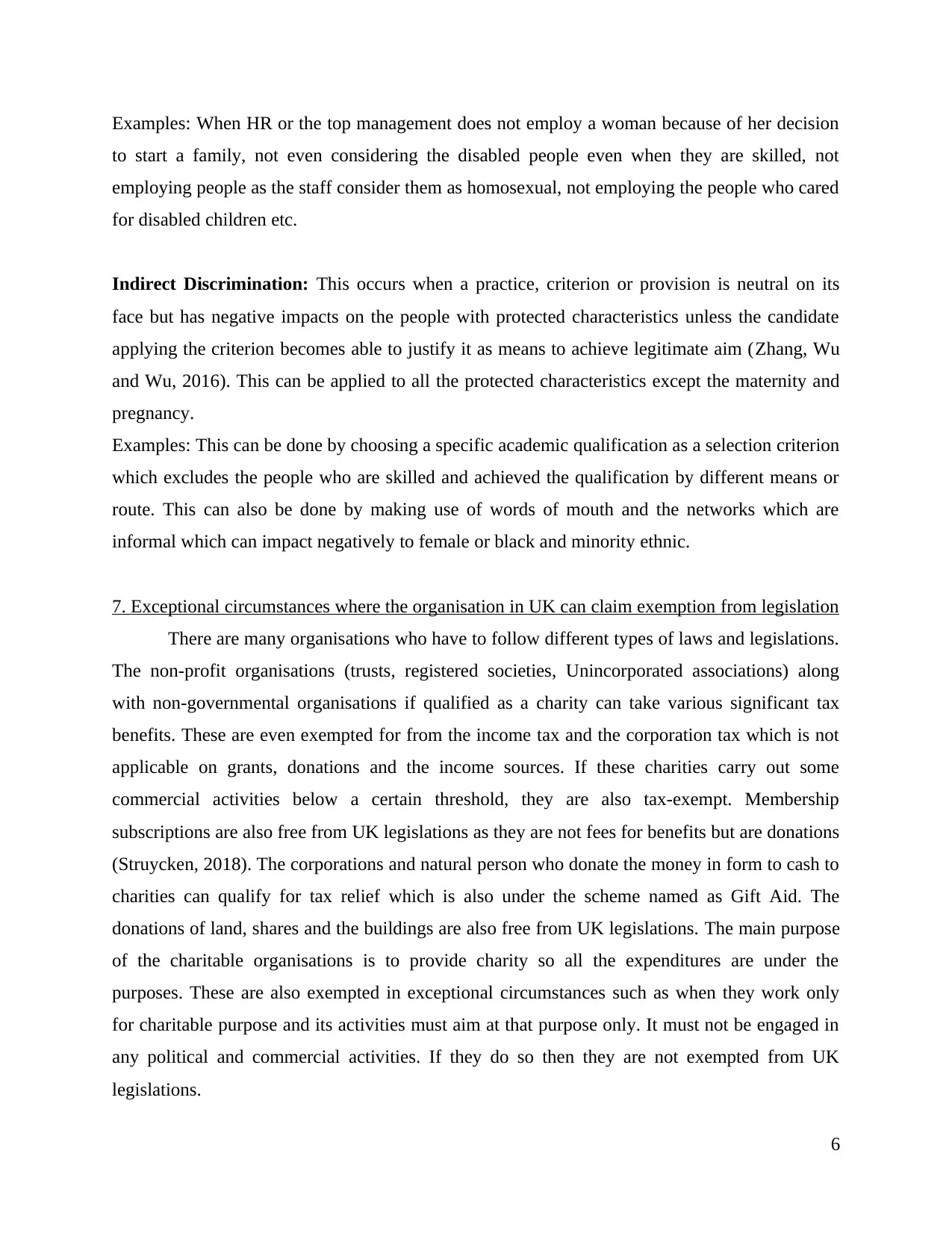
Examples: When HR or the top management does not employ a woman because of her decision
to start a family, not even considering the disabled people even when they are skilled, not
employing people as the staff consider them as homosexual, not employing the people who cared
for disabled children etc.
Indirect Discrimination: This occurs when a practice, criterion or provision is neutral on its
face but has negative impacts on the people with protected characteristics unless the candidate
applying the criterion becomes able to justify it as means to achieve legitimate aim (Zhang, Wu
and Wu, 2016). This can be applied to all the protected characteristics except the maternity and
pregnancy.
Examples: This can be done by choosing a specific academic qualification as a selection criterion
which excludes the people who are skilled and achieved the qualification by different means or
route. This can also be done by making use of words of mouth and the networks which are
informal which can impact negatively to female or black and minority ethnic.
7. Exceptional circumstances where the organisation in UK can claim exemption from legislation
There are many organisations who have to follow different types of laws and legislations.
The non-profit organisations (trusts, registered societies, Unincorporated associations) along
with non-governmental organisations if qualified as a charity can take various significant tax
benefits. These are even exempted for from the income tax and the corporation tax which is not
applicable on grants, donations and the income sources. If these charities carry out some
commercial activities below a certain threshold, they are also tax-exempt. Membership
subscriptions are also free from UK legislations as they are not fees for benefits but are donations
(Struycken, 2018). The corporations and natural person who donate the money in form to cash to
charities can qualify for tax relief which is also under the scheme named as Gift Aid. The
donations of land, shares and the buildings are also free from UK legislations. The main purpose
of the charitable organisations is to provide charity so all the expenditures are under the
purposes. These are also exempted in exceptional circumstances such as when they work only
for charitable purpose and its activities must aim at that purpose only. It must not be engaged in
any political and commercial activities. If they do so then they are not exempted from UK
legislations.
6
to start a family, not even considering the disabled people even when they are skilled, not
employing people as the staff consider them as homosexual, not employing the people who cared
for disabled children etc.
Indirect Discrimination: This occurs when a practice, criterion or provision is neutral on its
face but has negative impacts on the people with protected characteristics unless the candidate
applying the criterion becomes able to justify it as means to achieve legitimate aim (Zhang, Wu
and Wu, 2016). This can be applied to all the protected characteristics except the maternity and
pregnancy.
Examples: This can be done by choosing a specific academic qualification as a selection criterion
which excludes the people who are skilled and achieved the qualification by different means or
route. This can also be done by making use of words of mouth and the networks which are
informal which can impact negatively to female or black and minority ethnic.
7. Exceptional circumstances where the organisation in UK can claim exemption from legislation
There are many organisations who have to follow different types of laws and legislations.
The non-profit organisations (trusts, registered societies, Unincorporated associations) along
with non-governmental organisations if qualified as a charity can take various significant tax
benefits. These are even exempted for from the income tax and the corporation tax which is not
applicable on grants, donations and the income sources. If these charities carry out some
commercial activities below a certain threshold, they are also tax-exempt. Membership
subscriptions are also free from UK legislations as they are not fees for benefits but are donations
(Struycken, 2018). The corporations and natural person who donate the money in form to cash to
charities can qualify for tax relief which is also under the scheme named as Gift Aid. The
donations of land, shares and the buildings are also free from UK legislations. The main purpose
of the charitable organisations is to provide charity so all the expenditures are under the
purposes. These are also exempted in exceptional circumstances such as when they work only
for charitable purpose and its activities must aim at that purpose only. It must not be engaged in
any political and commercial activities. If they do so then they are not exempted from UK
legislations.
6
⊘ This is a preview!⊘
Do you want full access?
Subscribe today to unlock all pages.

Trusted by 1+ million students worldwide
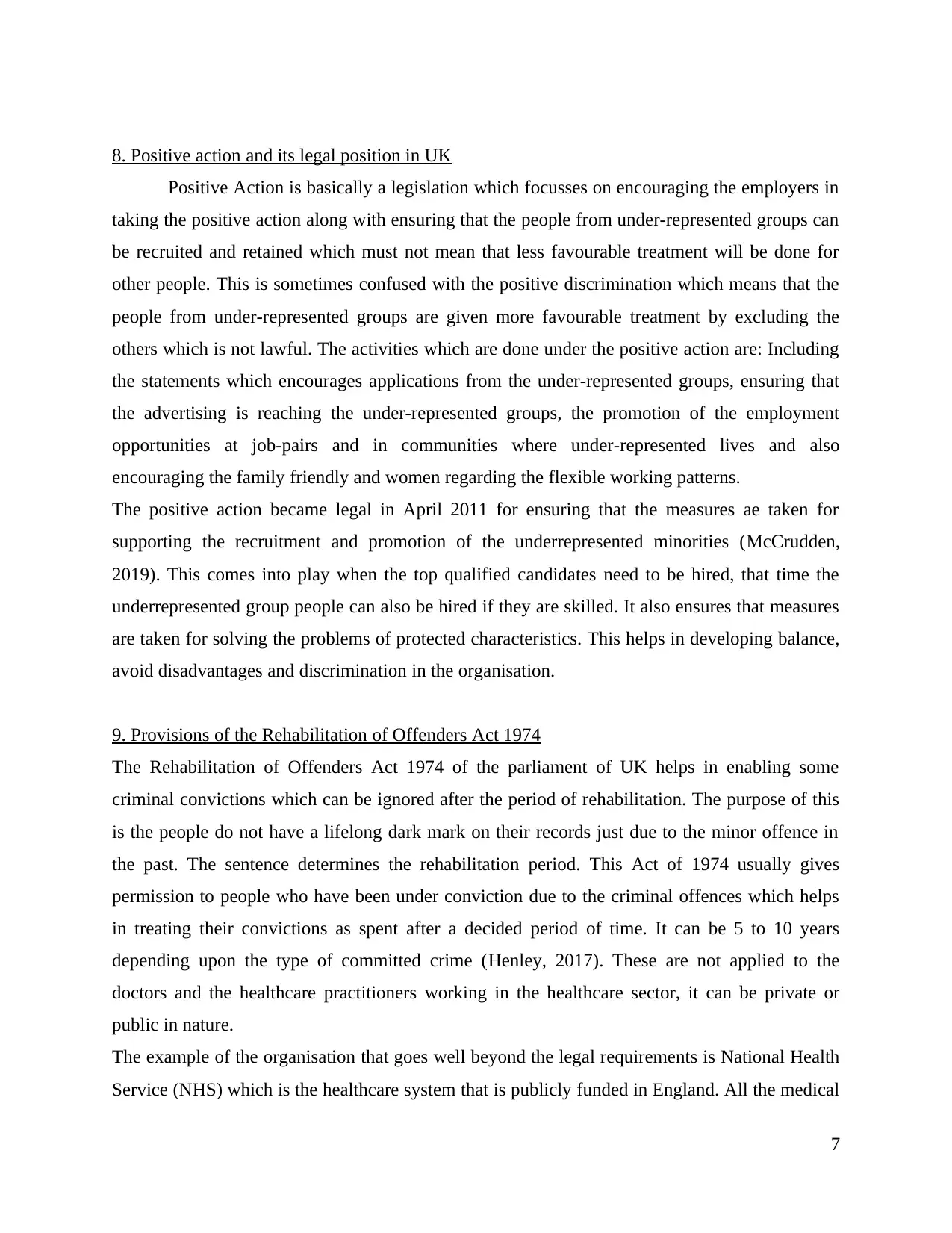
8. Positive action and its legal position in UK
Positive Action is basically a legislation which focusses on encouraging the employers in
taking the positive action along with ensuring that the people from under-represented groups can
be recruited and retained which must not mean that less favourable treatment will be done for
other people. This is sometimes confused with the positive discrimination which means that the
people from under-represented groups are given more favourable treatment by excluding the
others which is not lawful. The activities which are done under the positive action are: Including
the statements which encourages applications from the under-represented groups, ensuring that
the advertising is reaching the under-represented groups, the promotion of the employment
opportunities at job-pairs and in communities where under-represented lives and also
encouraging the family friendly and women regarding the flexible working patterns.
The positive action became legal in April 2011 for ensuring that the measures ae taken for
supporting the recruitment and promotion of the underrepresented minorities (McCrudden,
2019). This comes into play when the top qualified candidates need to be hired, that time the
underrepresented group people can also be hired if they are skilled. It also ensures that measures
are taken for solving the problems of protected characteristics. This helps in developing balance,
avoid disadvantages and discrimination in the organisation.
9. Provisions of the Rehabilitation of Offenders Act 1974
The Rehabilitation of Offenders Act 1974 of the parliament of UK helps in enabling some
criminal convictions which can be ignored after the period of rehabilitation. The purpose of this
is the people do not have a lifelong dark mark on their records just due to the minor offence in
the past. The sentence determines the rehabilitation period. This Act of 1974 usually gives
permission to people who have been under conviction due to the criminal offences which helps
in treating their convictions as spent after a decided period of time. It can be 5 to 10 years
depending upon the type of committed crime (Henley, 2017). These are not applied to the
doctors and the healthcare practitioners working in the healthcare sector, it can be private or
public in nature.
The example of the organisation that goes well beyond the legal requirements is National Health
Service (NHS) which is the healthcare system that is publicly funded in England. All the medical
7
Positive Action is basically a legislation which focusses on encouraging the employers in
taking the positive action along with ensuring that the people from under-represented groups can
be recruited and retained which must not mean that less favourable treatment will be done for
other people. This is sometimes confused with the positive discrimination which means that the
people from under-represented groups are given more favourable treatment by excluding the
others which is not lawful. The activities which are done under the positive action are: Including
the statements which encourages applications from the under-represented groups, ensuring that
the advertising is reaching the under-represented groups, the promotion of the employment
opportunities at job-pairs and in communities where under-represented lives and also
encouraging the family friendly and women regarding the flexible working patterns.
The positive action became legal in April 2011 for ensuring that the measures ae taken for
supporting the recruitment and promotion of the underrepresented minorities (McCrudden,
2019). This comes into play when the top qualified candidates need to be hired, that time the
underrepresented group people can also be hired if they are skilled. It also ensures that measures
are taken for solving the problems of protected characteristics. This helps in developing balance,
avoid disadvantages and discrimination in the organisation.
9. Provisions of the Rehabilitation of Offenders Act 1974
The Rehabilitation of Offenders Act 1974 of the parliament of UK helps in enabling some
criminal convictions which can be ignored after the period of rehabilitation. The purpose of this
is the people do not have a lifelong dark mark on their records just due to the minor offence in
the past. The sentence determines the rehabilitation period. This Act of 1974 usually gives
permission to people who have been under conviction due to the criminal offences which helps
in treating their convictions as spent after a decided period of time. It can be 5 to 10 years
depending upon the type of committed crime (Henley, 2017). These are not applied to the
doctors and the healthcare practitioners working in the healthcare sector, it can be private or
public in nature.
The example of the organisation that goes well beyond the legal requirements is National Health
Service (NHS) which is the healthcare system that is publicly funded in England. All the medical
7
Paraphrase This Document
Need a fresh take? Get an instant paraphrase of this document with our AI Paraphraser

practitioners must disclose the convictions of criminal while applying jobs in healthcare settings
in UK. If they don’t, they will be lead to sacking of that employee and additionally reported to
the GMC in case of misconduct. Convictions must be disclosed to avoid any misunderstandings.
10. Practical policies adopted for diversity, equality and inclusion
Diversity, Inclusion and Equality together helps in developing approach which can help
in recognizing that everyone is unique and can make their contribution, knowledge, experience
and skills to the organisation. There are various policies which the organisations can use to
promote diversity, equality and inclusion in the workplace. These can be creating the culture of
fairness and inclusion. It helps in supporting and demonstrating the inclusion through operations
which are fair and transparent (Williamson, Carson and Foley, 2019). The organisations must
also offer the staff appropriate the diversity and inclusion training which helps in raising
awareness and to provide the understanding regarding the issues regarding difficult subjects like
the unconscious bias. The policy in which the unconscious bias can be identified and prevented
can be implemented which can help in recognizing the traits and also in enabling the individuals
to challenge the negative biases. The company must ensure that the discrimination is not done on
any basis and for this anti-discrimination policies can be implemented. The policy must be
applied for everybody irrespective of the differences in any aspect whether it is age, race,
religion, disability, gender or any other. They can involve the policies of recruitment and
selection so that variety of colleagues can be involved and everyone better understands their
roles and responsibilities.
8
in UK. If they don’t, they will be lead to sacking of that employee and additionally reported to
the GMC in case of misconduct. Convictions must be disclosed to avoid any misunderstandings.
10. Practical policies adopted for diversity, equality and inclusion
Diversity, Inclusion and Equality together helps in developing approach which can help
in recognizing that everyone is unique and can make their contribution, knowledge, experience
and skills to the organisation. There are various policies which the organisations can use to
promote diversity, equality and inclusion in the workplace. These can be creating the culture of
fairness and inclusion. It helps in supporting and demonstrating the inclusion through operations
which are fair and transparent (Williamson, Carson and Foley, 2019). The organisations must
also offer the staff appropriate the diversity and inclusion training which helps in raising
awareness and to provide the understanding regarding the issues regarding difficult subjects like
the unconscious bias. The policy in which the unconscious bias can be identified and prevented
can be implemented which can help in recognizing the traits and also in enabling the individuals
to challenge the negative biases. The company must ensure that the discrimination is not done on
any basis and for this anti-discrimination policies can be implemented. The policy must be
applied for everybody irrespective of the differences in any aspect whether it is age, race,
religion, disability, gender or any other. They can involve the policies of recruitment and
selection so that variety of colleagues can be involved and everyone better understands their
roles and responsibilities.
8

REFERENCES
Books and Journals
Bowl, M., 2018. Differentiation, distinction and equality–or diversity? The language of the
marketised university: an England, New Zealand comparison. Studies in Higher
Education. 43(4). pp.671-688.
Fires, P.M. and Sharperson, K.E., 2017. Making the Case: How Diversity and Inclusion Can
Improve Your Firm’s Financial Outlook.
Henley, A., 2017. Criminal records and the regulation of redemption: a critical history of legal
rehabilitation in England and Wales (Doctoral dissertation, Keele University).
McCrudden, C., 2019. Gender-based positive action in employment in Europe: a comparative
analysis of legal and policy approaches in the EU and EEA. Available at SSRN
3524238.
Ng, E.S. and Sears, G.J., 2020. Walking the talk on diversity: CEO beliefs, moral values, and the
implementation of workplace diversity practices. Journal of Business Ethics. 164(3).
pp.437-450.
Roberto, F. and et.al., 2020. The academic “glass-ceiling”: investigating the increase of female
academicians in Italy. International Journal of Organizational Analysis.
Shortland, S. and Perkins, S.J., 2020. Women's expatriate careers: losing trust in organisational
equality and diversity policy implementation?. Journal of Global Mobility: The Home of
Expatriate Management Research.
Struycken, A.V.M., 2018. State nationality and religious family law: some notes. Netherlands
International Law Review. 65(3). pp.481-496.
Williamson, S., Carson, L. and Foley, M., 2019. Representations of New Public Management in
Australian Public Service gender equality policies. Equality, Diversity and Inclusion:
An International Journal.
Zhang, L., Wu, Y. and Wu, X., 2016. A causal framework for discovering and removing direct
and indirect discrimination. arXiv preprint arXiv:1611.07509.
9
Books and Journals
Bowl, M., 2018. Differentiation, distinction and equality–or diversity? The language of the
marketised university: an England, New Zealand comparison. Studies in Higher
Education. 43(4). pp.671-688.
Fires, P.M. and Sharperson, K.E., 2017. Making the Case: How Diversity and Inclusion Can
Improve Your Firm’s Financial Outlook.
Henley, A., 2017. Criminal records and the regulation of redemption: a critical history of legal
rehabilitation in England and Wales (Doctoral dissertation, Keele University).
McCrudden, C., 2019. Gender-based positive action in employment in Europe: a comparative
analysis of legal and policy approaches in the EU and EEA. Available at SSRN
3524238.
Ng, E.S. and Sears, G.J., 2020. Walking the talk on diversity: CEO beliefs, moral values, and the
implementation of workplace diversity practices. Journal of Business Ethics. 164(3).
pp.437-450.
Roberto, F. and et.al., 2020. The academic “glass-ceiling”: investigating the increase of female
academicians in Italy. International Journal of Organizational Analysis.
Shortland, S. and Perkins, S.J., 2020. Women's expatriate careers: losing trust in organisational
equality and diversity policy implementation?. Journal of Global Mobility: The Home of
Expatriate Management Research.
Struycken, A.V.M., 2018. State nationality and religious family law: some notes. Netherlands
International Law Review. 65(3). pp.481-496.
Williamson, S., Carson, L. and Foley, M., 2019. Representations of New Public Management in
Australian Public Service gender equality policies. Equality, Diversity and Inclusion:
An International Journal.
Zhang, L., Wu, Y. and Wu, X., 2016. A causal framework for discovering and removing direct
and indirect discrimination. arXiv preprint arXiv:1611.07509.
9
⊘ This is a preview!⊘
Do you want full access?
Subscribe today to unlock all pages.

Trusted by 1+ million students worldwide

10
1 out of 10
Related Documents
Your All-in-One AI-Powered Toolkit for Academic Success.
+13062052269
info@desklib.com
Available 24*7 on WhatsApp / Email
![[object Object]](/_next/static/media/star-bottom.7253800d.svg)
Unlock your academic potential
Copyright © 2020–2025 A2Z Services. All Rights Reserved. Developed and managed by ZUCOL.




